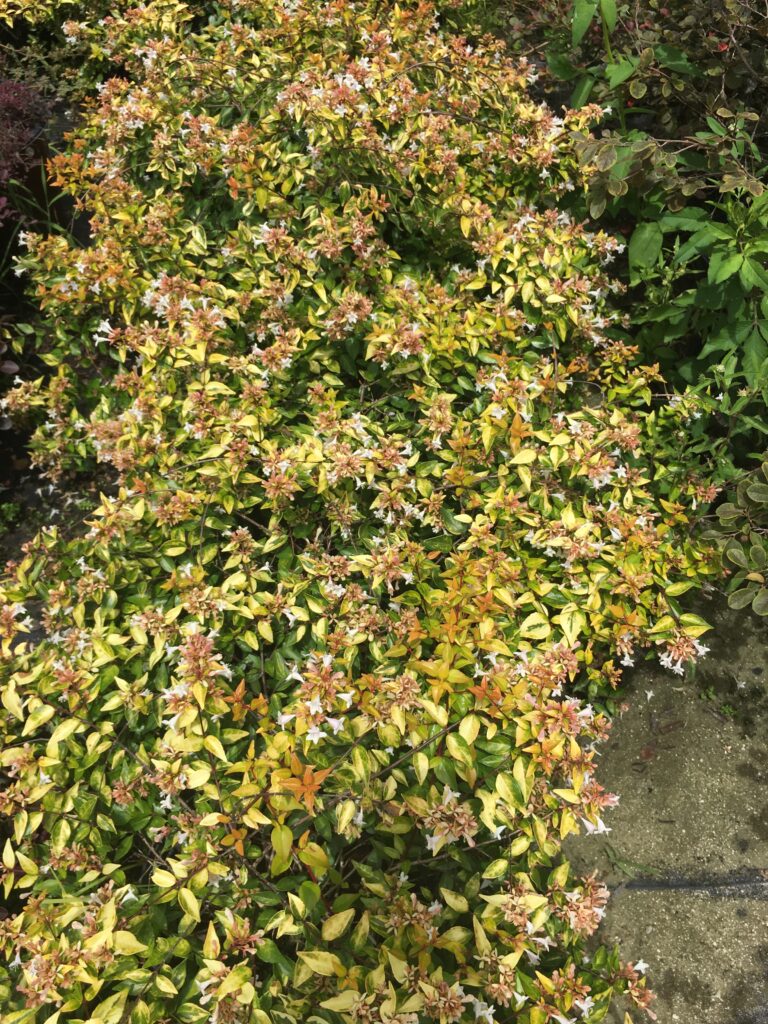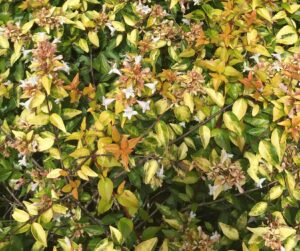Abelia Sunshine Daydream
for Northeast Florida,
Jacksonville | St. Augustine area Landscapes
( Abelia grandiflora / ( AKA Linnaea grandiflora) ‘Abelops’ beind grown and marketed under the name Abelia Sunshine Daydream)

Origins of Abelia Sunshine Daydream / Abelia /Linnaea grandiflora:
– The new Abelia cultivar is a naturally-occurring sport of Abelia×grandiflora ‘Little Richard’, (not patented green parent plant) The new cultivar was discovered as a branch mutation and selected during May 2007 in a controlled outdoor nursery environment in Zundart, The Netherlands. It has beautifully bright yellow and green variegated foliage and a lush full growth habit. Adds a really nice pop of color in the landscape and great texture as well.
Abelia grandiflora ‘Abelops’ Sunshine Daydreams partent plant Abelia grandiflora is considered native to areas of Asia. An heirloom garden plant and has long been a favored garden plant for attracting butterfly, hummingbird and other pollinators to the garden.
Sunshine daydream is almost identical to ‘Kaleidoscope’ and it is hard to tell the difference in the two, Sunshine daydream has a little bit of coloration difference and leaves are a bit smaller than Kaleidoscope but for me their overall appearance is the same other than Kaleidoscopes new growth is a brighter deeper red color.
Here is a link to the patent application information, the only thing that is confusing here is that, at least in our North Florida subtropical climate, the flowers are more whitish on the plants I have seen not lavender, so Im unsure why it is listed that way.
Preferred Exposure for Sunshine Daydream Abelia :
– Abelia grandiflora x Sunshine Daydream can be planted into full sun or part sun part shade situations here in the Northeast Florida, Jacksonville | St. Augustine area landscape.
– If planted into a full shade location that gets only indirect light all day, plants may not bloom as well and foliage can become a bit thinner or not as lush and full. Dappled sun throughout the day under tall trees works well or areas that will receive some sun and some shade during the day are more ideal.

Foliage of the Abelia grandiflora Sunshine Daydream:
– Small foliage is a glossy variegated bright yellow and green color, with reddish purple stems and new growth that is a bright rosy pink color. Evergreen in our subtropical climate zone for Jacksonville and St. Augustine areas of Northeast Florida.
Adds texture to the garden and contrasts well with larger foliage plants.
Soil Preference and Salt tolerance of Sunshine Daydream Abelia grandiflora:
– Abelia will prefer moist well drained soils but is quite drought tolerant when established into the landscape and little difference in vigor or bloom is noticed on Glossy Abelia when planted into a drier or sandy soil locatin with afternoon shade.
– Glossy Abelia are tolerant of moist soils for short periods, but avoid planting in areas that remain water logged after rains for prolonged periods.
- not particular about soil components and grow equally as well in sandy soils as they do in clay.
– Abelia shrubs have a low salt tolerance and should be avoided for coastal
plantings.
Size Variance of Glossy Abelia :
– Glossy Abelia can reach sizes of 3-4+ feet High | 3-4 feet Wide but are most often kept to about 4 ft with annual or semi annual pruning.
Space plants at a minimum of 2-3 ft from the center of one plant to the center of another for foundation plantings.
Growth Habit of Sunshine Daydream Abelia:
– Abelia Sunshine Daydream has an somewhat upright spreading shape. It has a somewhat reduced tendency to throw long branches compared to other grandiflora plant selections and grows moderately fast. Plants bloom on new growth so don’t be afraid to trim them back to shape, they will rebloom quickly after a pruning.
Growth Rate of the Glossy Abelia Sunshine Daydream:
– Moderately fast growing shrub quickly establishes itself into the landscape. Remember to trim 4-6 inches beneath where you would like to see the plants height and shape as they will re-flush new growth and blooms almost immediately after trimming. Expect to get 4-8″ of growth in a growing season until mature.
Blooms of the Sunshine Daydream Abelia plant:
– The blooms on these plants are spectacular and they just keep coming and coming! Dainty white, fragrant bell shaped bloossoms form in clusters on branch tips. Abelias bloom can bloom during the spring, summer and fall and attract butterflies, hummingbirds and other pollinators to their abundant source of nectar. Being in the honeysuckle family, it is a fun treat for kids to pick a bloom and suck the sweet nectar from the end of the bloom as you would honeysuckle blossoms. You can see what all the buzz is about from those pollinators bopping about!
Water Requirements of Abelia Sunshine Daydream :
– Abelia have fairly low water needs and are drought tolerant once they are established into the landscape. Remember to check their water needs daily after planting to get them rooted and established into the landscape quickly.
– Watering your newly planted smaller shrubs and flowers
Butterfly or Bird Attracting:
– Attracts butterflies hummingbirds and other pollinators to the garden. Long season blooms provide and excellent nectar source.
Best Uses For Abelia grandiflora x Abelops / Sunshine Daydream:
– Abelia grandiflora ‘Abelops’ Sunshine Daydream is a compact selection that responds well to pruning and is well suited to the smaller or middle layer of home foundation plantings or can be used as the back layer of lower landscape selections and allowed to grow untrimmed.
– Abelias are perfect for massed plantings in large groupings as under plantings for the edges of natural forested areas or larger native Oaks and Maples.
Care of S & J Nursery’s North Florida | Jacksonville | St. Augustine Abelia
Shrubs:
– Abelias should be pruned once or twice a year to shape when they begin to be untidy. The biggest mistake I see with these plants looking scraggly and unattractive in landscapes is that they bloom so much (they are seemingly always in bloom) so people are unwilling to trim off the blooms to shape the plant eventually leaving them with an unattractive plant that does not even have as many beautiful blooms as it would have had it just been given the shaping that it needed. Don’t be afraid to trim, they resprout quickly and bloom on that new growth! They may be trimmed at any time during the spring summer or fall months. If you trim late in fall or winter time the plant will flush new growth that may not have time to harden off before it is exposed to a cold snap and will be unsightly all winter long. A good rule of thumb for the North Florida are is not to prune in the late fall, wait until the weather warms in spring and give them a good trim, once they have bloomed and grown you may opt for another ‘haircut’ during mid summer to shape it up a bit.
– Abelia shrubs can be planted in the North Florida | Jacksonville | St. Augustine area at any time during the year. In normal and well draining soils dig the hole as deep as the root ball and two to three times as wide. Plant the top of the root ball level or slightly higher than the surrounding soils. Avoid planting in poorly drained soils.
– Check the plants water needs every day during the establishment period. For most 3 gallon size shrubs in the North Florida landscape in average soil, that is neither heavy clay that holds water or really sandy that will take 2-3 weeks of daily watering to ensure that your newly planted shrub will begin to put out new roots and grow into its new home happily. After the first few weeks begin tapering back your watering to every other day then every third day and so on until your newly planted items are flourishing without your assistance.
– Abelias may need supplemental irrigation during times of excessive heat or drought.
– IMPORTANT: If planting shrubs in heavy clay soils that hold allot of water after a rain or irrigating, remember to check the soil for moisture by sticking your fingers into the soil near the root ball of the newly planted shrub down to 2-3 inches. If it remains wet from the previous watering wait for the top 2-3 inches to dry out before watering again.
– IMPORTANT: When planting shrubs into poor sandy soils be sure to amend the planting hole by mixing compost or cow manure etc. with the native soil that will go back in the hole around the new plants root ball when installing your shrub material, this will not only give your new shrubs good soil to grow its new roots into but help it hold water.
– When planting shrubs from containers be sure to loosen the roots as much as possible pulling loose roots away from the root ball before installing your new plants, if the roots are to tight to easily loosen with your hands use a knife to cut a few slits into the root ball being careful to go all
the way from the top to the bottom and making the cut at least an inch deep. This will ensure that your plant will immediately begin to form new roots into its new surrounding soil.
Planting your new smaller shrubs and flowering plants
– Mulch newly planted shrubs whenever possible. Shrubs will benefit from a 3-4 inch layer of arborists wood chips, Pine bark or Pine Straw.
– Fertilize each spring with a shovelful of good garden compost or a mixture of Milorganite and a good quality slow release poly coated plant food like Stay Green or Osmocote. Be sure when fertilizing to sprinkle the fertilizer around the mulch circle underneath the foliage of the shrubs.
here is a link to more information on Abelia Sunshine Daydreams parent plant
https://edis.ifas.ufl.edu/pdffiles/FP/FP00100.pdf

